#Shueisha's seinen manga
Text
The Quiet Princess, the Knight, and the Samurai
dailymotion
#The 100 Girlfriends Who Really Really Really Really Really Love You#君のことが大大大大大好きな100人の彼女#Kimi no koto ga Dai Dai Dai Dai Daisuki na 100-nin no Kanojo#The 100 Girlfriends#100人の彼女#100-nin no Kanojo#Rikito Nakamura#Yukiko Nozawa#Shueisha#Shueisha's seinen manga#seinen manga#Weekly Young Jump#Seven Seas Entertainment#Bibury Animation Studios#Anime Fall 2023
1 note
·
View note
Text

Girls Jump (ガールズジャンプ) / Shūeisha (集英社) / 2012 issue
41 notes
·
View notes
Text

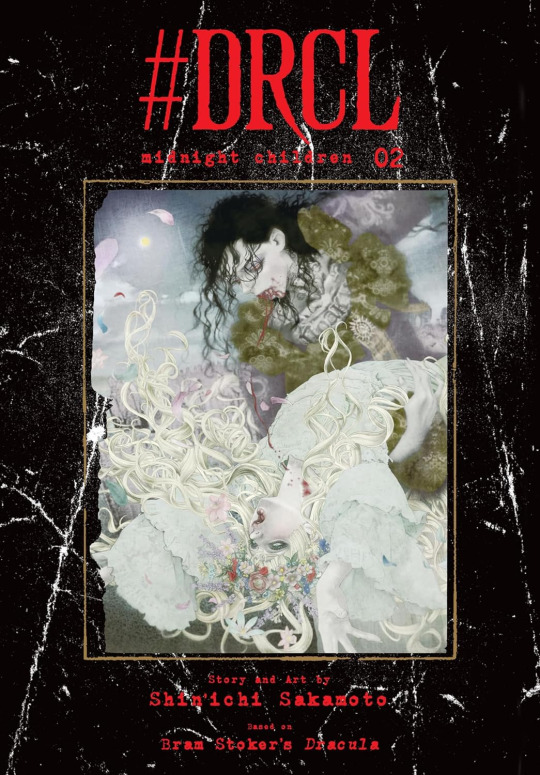
#drcl midnight children#shin'ichi sakamoto#dracula#viz media#shueisha#grand jump#seinen#seinen manga#manga#poll
7 notes
·
View notes
Text
Oshi no Ko Anime Adaption has been Officially Announced
Oshi no Ko Anime Adaption has been Officially Announced
#anime #manga #WeeklyYoungJump #赤坂アカ #横槍メンゴ #推しの子
Exciting news! It has been announced that the manga series Oshi no Ko has been picked up for an anime adaptation! Written by Aka Akasaka (Kaguya-sama, Love is War) and illustrated by Mengo Yokoyari (Scum’s Wish), in the world of Showbiz, “Lies are weapons.” Goro works as an OB-GYN in the countryside, a life far removed from the entertainment industry. Meanwhile, his favorite idol, Ai Hoshino, has…

View On WordPress
#Aka Akasaka#Anime#Anime Adaption#Kaguya-sama: Love Is War#Manga#Manga Plus#Mengo Yokohari#Oshi no Ko#Scum&039;s Wish#Seinen Series#Shueisha Inc#Studio Doga Kobo#Weekly Young Jump#推しの子
0 notes
Note
I was today years old when I discovered that, apparently, Shounen Jump doesn't allow women to be editors/helpers 🙃 now it may be false information, but that would help explain why WS is the way it is now... To this day I am baffled that Hetalia is considered shounen/seinen... I understand that unfortunately shoujo/josei isn't as popular, but I very seldom see men, even jp men (which are apparently the supposed main audience) be fans of Hetalia or supporting its merch. Most of the money Hetalia gets seems to come from jp women. Hell, it doesn't even seem to be a Bungou Stray Dogs case where they make the series appealing for both genders. With it's lack of shounen-esque battles, latent homoerotic content (especially in the ye old days), fanservice which even to this day is 90% of the time focused on the male characters... I have to wonder, what does this series have going on for a male cishet audience? The very ocasional boob joke? The (now practically nonexistent) historical content? I'm confused...
Sorry for the rant, I hope it isn't too much 😅
[Sorry this post became pretty long because I can't shut the hell up!]
I looked a bit into it and, unfortunately, it seems to be true. Apparently they use "you need to understand what's in a young boy's heart" as an excuse to sort of gatekeep women from having a career as an editor with them.
I have read a couple articles about this, and the way Shueisha seems to dismiss the issue is pretty disturbing.
The later deleted tweets from the (female) author of Rocking You!!! really speaks volume of the situation beyond any corporate clarification Shueisha released on the matter:

[Source] [Source]
Sadly, the manga&anime mainstream/dominant scene is still pretty sexist and it's no wonder that many female and/or queer artists prefer to engage in more niche, somewhat still frowned upon genres like BL or Josei, at least they probably have more freedom there when it comes to sharing stories since they don't need to appeal to what a narrow-minded, sexist and conservative mindset still deems as manga's main demography - cishet male teens and young men ... Which is, well, the reason why most shows are required to have cute lil' objectified girlies as fanservice (I'm not against fanservice per se but you know what I mean, it's how unbalanced it is between genders in "romance/sexual-neutral" stories - like Shounen are supposed to be! - what makes it overwhelming and insulting) even if they don't even need it as a crutch for engagement.
Personally, I believe Hetalia's og target as a Seinen wasn't wrong. I think that Himaruya being a man did have an impact in how Hetalia came to be and how its comedy and characters, and even art style developed. It wouldn't feel right to me to call it a Shoujo or a Josei.
The problem with this traditional classification is that what's a Shoujo/Josei wasn't quite established as "what girls want to see", but rather "what boys typically aren't interested in." And obviously, this soon led to the over-simplified and kinda sexist idea that Shounen=Action-packed battles; Shoujo=Romance.
Many Shounen and Seinen have quite a large female presence in their fandoms despite being traditionally seen as the "boys/men's manga", whereas it is less likely for a boy or a man to be very into a Shoujo, and even less into a Josei (or, rather, it is less likely for a male to share this interest because of good ol' toxic masculinity).

In any case, while searching some stuff to form my own opinion and answer, i came across this page where they said "if a series does not fit into any other category such as Shonen or Shojo, then it will be put under Seinen", and honestly I think it makes the most sense for Hetalia.
For how I see it, the "problem" with targetizing Hetalia is that Himaruya never thought about it becoming popular when he started it. His mindset was "let's post this random silly one-time thing I came up with after engaging in a thread on 2Chan while passing time as a student in New York".
There wasn't any intended 'commercial use', there was no business planning beforehand. It'd be like trying to put a target on, I dunno, some everyday life meme-y comics you find daily on social media. They have no inherent target, though they might end up resonating with one group of people more than others. But you cannot know until the thing actually starts resonating with an audience.
The 2Chan threads in question, according to the informations I gathered, actually dealt with topics that tend to resonate with a male audience more: a debate about military weapons and strategies used in WW2 that culminated with talking about Italy's military failures of the time; and how Japan will literally make moe girlies as personifications for anything.
Himaruya just had this idea, definitely influenced by his time spent in a multiethnic background while he was in the US, to fundamentally make a comic inspired by those moe female personifications but have them be moe guys instead.
It would've been very hard for Himaruya to foresee the attention his work would've gotten, let alone the kind of audience that would actually be interested in it.
Sure, Himaruya apparently called himself a Fudanshi once (I have no source for this though so take it with a grain of salt!) and it's not hard to believe, but Hetalia is very atypical even for a BL-leaning series.
Let's not forget that the first one-shot Hetalia strip was posted on Hima's blog in 2006.
And, let's say, things back then were quite different. Yaoi/BL wasn't nearly as popular as it became later, and mainstream media didn't really discover the power of fanservice aimed at a female audience yet (that would come much, much later and kind of peaked with Free!, which I believe really made a difference in how anime business would perceive the true power of this kind of fanservice from then on).
In 2006, not even Junjou Romantica had gotten an anime yet, and as much as I honestly dislike JR, it played a big role in making BL more popular because prior to that BLs could barely aspire to get anything more than a couple OVAs. The few that did get a proper anime season (like Gravitation, Loveless and Sukisho) still didn't get as much of a hype to make the "male-dominated mainstream community" notice their existence like JR somehow did.
I'm not even sure the kind of "fanservice" Hetalia made/makes use of was a thing in 2006. Like, you know, all those anime we have now that have tons of homoerotic subtext, a predominantly or exclusively male cast, are targeted at least partially at a female audience but never actually dip into romance or make anything really canon?
I'm no expert, but I don't think they were a thing back then, and if they did they were quite niche. Perhaps Hetalia also changed the male perception of female audience in manga/anime spaces.
Hetalia fans back then were quite ostracized and shamed merely for being girls enjoying a show with a kind of content that most cishet males - used to their shows with everything geared towards them (and girls confined to the "Romance Shoujo enclosure") - couldn't quite comprehend.
I've seen so many male anime fans, back in the day, making fun of us simply for being girls and enjoying a comedy that features hot guys with all the homoerotic subtext they wouldn't bat an eye at if it was between female characters.
However it is worth noting that, while most Hetalia fans are girls or women, it has a minority of male fans as well. One of the two friends that actually introduced me to Hetalia was a boy, and I was introduced to it together with three other friends, one of which was a boy too - we all loved it at first sight!
An Italian Youtuber I occasionally follow revealed that his very first manga was Hetalia and although he only picked it up to get closer to the girl he liked, I guess he didn't hate it enough to just drop it and "unlike" that girl lol
I saw reactions of a few other guys to Hetalia episodes and none of them hated it, they even laughed at some jokes!
I believe that many men are simply prejudiced against Hetalia because of internalized sexism or toxic masculinity, especially if they're aware of the fandom's main activity being shipping (lol).
I don't think Himaruya made any of his """fanservice""" with an actual fanservice-y intent, he simply, genuinely drew what he, before anyone else, enjoyed drawing. Unlike a lot of fanservice out there, Hetalia's never feels forced, it is very genuine.
[Conclusion; if you wanna skip what's above lol]
I don't think it's fair to say that Hetalia willingly attempts to appeal to women. I feel like Hetalia, at least pre-HWS Hetalia, appealed to Himaruya before and foremost. It just so happened that Himaruya's taste aligned more with a female audience, despite being actually funny in a gender-neutral way that way too many cishet guys dismiss because of (I guess?) fragile masculinity and fandom prejudice.
So, keeping that into account, I really do not think it'd be fair to call Hetalia a Shoujo or a Josei. And it isn't fair to call it a Shounen either, because we see how Hetalia's essence and humor was undoubtedly butchered by Shounen Jump+'s editing and rules, that simply do not align with either Hetalia's spirit nor its main audience's expectations.
As a Seinen, Hetalia had freedom to be whatever it wanted because Seinen tends to have more loose rules for what is or isn't allowed in one. Because its target of "adult men" is basically, de facto, a neutral catch-all label. Josei tends to be too involved in classic Shoujo dynamics and themes, albeit in a more mature sauce, and while there are exceptions I feel, in all the (few) Josei I crossed path with, there is a certain je-ne-sais-quoi that makes it undoubtedly more inherently feminine than Hetalia is.
It's funny because this whole debate over Hetalia's target kind of reminds me of how the very first BL, Kaze To Ki No Uta, is classified as a Shoujo because back then Yaoi didn't exist as an official genre.
When you make something revolutionary that defies pre-existing rules and boxes, it's hard to slap a specific label on it that feels right.
#hetalia#this is long but I hope it wasn't too boring lol#actually I'm curious so I'm going to make a poll about this#what genre is Hetalia?? HETALIA IS HETALIA lol#ary spoke#ask
68 notes
·
View notes
Text
"Shinjo Mayu: Exploitation of Mangakas by Publishers"
I didn't know what to start this blog with until yesterday, I woke up and read a tremendous article of manga artist Shinjo Mayu. I couldn't resist talking about this queen who has been shaking up the Japanese publishing world recently, and I would like to share her experience and thoughts.

First, let's get to know Shinjo Mayu and how she has reached this point.
Shinjo Mayu (新條 まゆ) is a Japanese manga artist who was born in Nagasaki Prefecture in 1973. She graduated from Yukokan High School and made her debut in Shogakukan's Sho-Comi magazine in the special edition released on February 14, 1994, with "あなたの色に染まりたい." Her success skyrocketed with "Kaikan Phrase" (1996-2000), published in the same magazine as her debut, which was also adapted into an anime between 1999-2000, totaling 44 episodes.

On May 23, 2007, Shinjo Mayu announced on her blog that she would be leaving the Shogakukan publishing company to become an independent artist. Without giving many details, she mentioned that she planned to experiment with different things.
Nearly a year later, she opened up and stated that she left because the demands from her editors were too stressful and degrading. She even disclosed being threatened by an editor that her previous works would cease to be printed if she left. Seeking legal advice, fortunately, her works continued to be printed. She has expressed that many writers feel dissatisfaction working at Shogakukan due to excessive pressure. Even her editor, when she began creating manga, told her that "she was a manga creator akin to a worm who would never become a serialized manga creator no matter how hard she tried." She revealed that as a mangaka at Shogakukan, she had drawn up to 120 pages a month with an average of 3 hours of sleep per day.
During this time, she has become a highly versatile manga artist, creating works spanning various genres such as shojo, shonen, seinen, and BL. Additionally, she oversees a comprehensive housing production called Maison de Cocon. In 2021, she started a new series titled "Nijiiro no Ryuu wa Megami wo Daku" which is available on various manga applications.
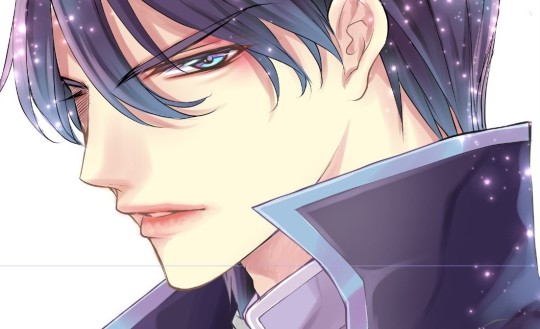
Many authors, including Shinjo Mayu, feel distressed by the sudden passing of mangaka Ashihara Hinako. Even today, her case is still being discussed in the news and on social media. I will make a separate post about this topic, but in summary, Ashihara Hinako posted on January 26th on her blog a critique of Nippon TV because the television adaptation of her manga "Sexy Tanaka-san" was not faithful to her original work. She emphasized that she had repeatedly told Shogakukan to urge them to take action, but without success. She later deleted the post and apologized. However, on January 29th, her lifeless body was found in Nikko, Tochigi Prefecture, under suspicion of suicide.
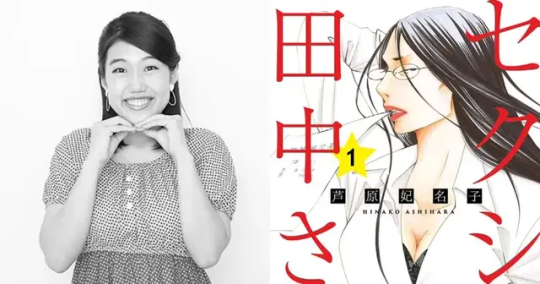
Since then, Shinjo Mayu has expressed that not a day goes by without her remembering Ashihara Hinako and what led to her tragic end. Through social media, she denounces the mistreatment that manga artists receive, specifically at Shogakukan. She mentioned that when she wrote the blog about her departure from Shogakukan, an editor told her that there was a meeting where they said they "should control the writers so they don't make such big statements." On the other hand, at Shueisha, they said: "Before something like this happens, let's find out if the writers are dissatisfied."
Clearly, there are very good relationships between editors, manga artists, and publishers. However, as we have seen, there are also times when relationships are not so good. But it was yesterday, February 14th, where she exposed the Japanese publishing world by publishing an article on note.com titled "The Era is Beginning Where Manga Artists are Being Exploited by Publishers."
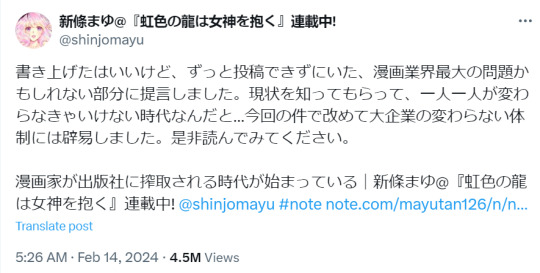
She has firmly expressed that she doesn't care about the consequences her statements may have on opportunities with other publishers, although she feels it is necessary to do so. From their manga, manga artists only receive 10% of the profit. In the past, working with an editor made things easier for manga artists as they only had to worry about drawing the manga. Editors, on the other hand, took on many responsibilities such as promotion and distribution. This is how they consolidated their role in the publishing industry. Therefore, the remaining 90% of the profit was considered "necessary expenses." However, now, in the digital era of e-books, manga delivery is simplified as the manga artist only has to create the manuscripts and send them. The functions between the editorial department and the publisher have been divided. Publishers are now responsible for granting distribution licenses to platforms and transmitting data. Overall, publishers have less work than before, so what is the true involvement of publishers in e-books? The royalty rate for manga artists in e-books is between 15% and 20%, but few people receive 20%. Previously, negotiating to increase e-book rights put distributors in a very vulnerable position due to threats from Shogakukan, as Shinjo makes clear: "without manga provided by the publisher, there was nothing to distribute." But the situation has now reversed, and it is the publishers who ask for works to be converted into e-books. Over time, more authors realized that publishers were charging too much in terms of e-book royalty rates. In this way, the publisher becomes an exploiting intermediary. Distribution companies don't charge as much because they aren't the authors; but publishers, who own the related author rights, receive significant rates without doing as much work.
Shinjo Mayu denounces that publishers are paying very low salaries to their staff and encourages manga artists to seek fair and equitable compensation for their work. She also urges publishers to recognize and adequately support those who contribute to the creative process.
Currently, she works at the distribution company "ナンバーナイン," which has an editorial department. Therefore, the company itself is responsible for sending data to applications, conducting advertising, negotiating, and managing the data transfer and management process on behalf of the mangaka. However, their editorial department is responsible for providing feedback on manga, creating data reports, and offering advice and guidance. Shinjo Mayu considers these companies to be modern and flexible, so it's a good idea to try negotiating manga and distribution fees. In fact, she says that one can be a manga artist without needing to go through a traditional publisher.
I wonder if publishers could be in danger in the future for not offering their workers the respect and rights they deserve. I love magazines, but Shogakukan is getting a terrible reputation for not taking care of its artists (and for quite some time). Some are even encouraging a boycott of the publisher.
"Who can truly say they are supporting manga artists when those who work the hardest are the ones receiving the least money?" - Shinjo Mayu.

Sources:
https://www3.nhk.or.jp/news/html/20240208/k10014352711000.html
https://www.sponichi.co.jp/entertainment/news/2024/02/07/kiji/20240207s00041000428000c.html
https://note.com/mayutan126/n/n54607a9ecd37?sub_rt=share_b
https://www.animenewsnetwork.com/news/2007-06-05/sensual-phrase's-mayu-shinjo-leaves-shogakukan
https://www.animenewsnetwork.com/news/2008-06-10/sensual-phrase-shinjo-explains-why-she-left-magazine
https://book.hikaritv.net/book/static/141015_magazine/data/index.html
https://twitter.com/shinjomayu/status/1755101152188969429
https://twitter.com/shinjomayu/status/1757622214437072975
18 notes
·
View notes
Text
why I have a lot of caveats when I talk about manga demographics
In the past when I've rambled in more detail about manga demographics I've struggled to keep a balance between "this is how things are, I'm not going to leave room for ambiguity because I'm tired of seeing people perpetuating misinformation" and "but this is not actually how things always are, caveat caveat caveat". I've been wanting to write a bit more about why, exactly, this is, and today I randomly found a good angle to explain it, so this is that post.
After watching that "what is shojo?" video, I went to idly browse the person's twitter, where I saw them being angry about Shojo Beat licensing a series from Shonen Jump+ for English-language release.
And at first I was like "Yeah, this sucks! Grr Shojo Beat! I hate them! Grr!" because I hold petty grudges against Shojo Beat (and Viz to a lesser degree), but once I was over that automatic reaction, my thought was actually "Well, yeah, this is what's happening now, and will happen more and more in the future."
Because Shonen Jump+ is not a magazine. It's an online platform for manga publishing which holds the name "Shonen Jump" because it began as an online supplemental to Shonen Jump, but has since moved on to become a thing of its own -- a new model for manga publishing. This departure of the manga industry from the magazine-based model will break down demographics, chiefly because on online platforms readers can pick and choose which titles to buy and read, rather than buying a magazine which contains a pre-selected set of manga tied together by a demographic. And what we need to keep in mind is, this "moving away from demographics" is intentional on Shueisha's part. If it wasn't, Jump+ would not have recruited Kamio Yoko to publish a sequel to Hana yori dango, one of the best selling shojo manga in history.
Why is Shueisha doing this? Because they know magazines are dying. Because they know the market is already highly segmented and only becoming more so, and selling pre-packaged sets of manga will not work in the future -- the exact same reason network TV is dying while streaming has become the new standard. Because young promising artists are online, drawing and posting manga with little care for target demographics (because many of them probably never read manga magazines and posting their work to the internet is second nature to them), and they need to recruit these artists and have a place to commercialize their work -- the same reason they recruited ONE from the internet and ran the One Punch Man remake. Because they're not dumb, and know they have to change their business model in order to keep making money off manga.
Now I'm not going to claim Shonen Jump+ isn't still majorly shonen and seinen-focused. It is. But it's also obvious they're more than willing to explore a different model of manga publishing than what Shonen Jump has been doing for the past 50-odd years, and Jump+ running a manga the artist classifies as "shojo manga" and deciding to publish it under a shojo manga imprint, that can't be anything but a deliberate experiment.
And this will likely keep happening, and the demographics become more and more blurry, until we end up in a place where they no longer hold any meaning -- maybe. Or maybe the online platforms (at least the major ones) will also become segmented, and carry on the tradition of how manga publishing has targeted audiences since before WW2. Who knows? We're in a transitional period, and one that has been a long way coming.
What I personally think about it is, eh, I feel like the process is moving towards a place where "undefinied" manga that doesn't fall neatly into the stereotypes of any demographic is just going to loosely be categorized as "shonen" or "seinen" upon tankobon release, making those the catch-all, "default" category of manga, and I'm not sure how I feel about that. On the other hand I also really like platforms like Kurage Bunch which runs a lot of really good and interesting manga that typically fall outside what you will see in magazines aimed at tight demographics, and I like manga like that a lot, so I'm positive about online platforms that explore new ways of recruiting artists and publishing manga. So. I dunno.
206 notes
·
View notes
Text
Q-TA MINAMI
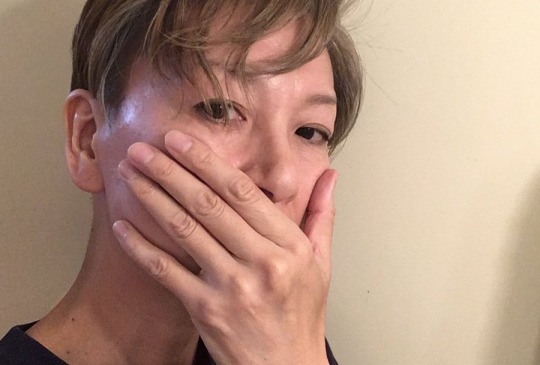
is a non-binary, bisexual, and feminist mangaka. Their manga stands out for dealing with issues such as sexuality, both in adolescence and adulthood, motherhood or everyday life. Which is why the demographics in which they are best known are seinen and especially josei.
Also known as Kyuta Minami, were born in Unnan City in Shimane Prefecture on January 13, 1969, although they currently live in Tokyo.
Q-ta graduated from Joshibi University of Art and Design Junior College Department of Design. Minami began working as a doujinshi artist during college and continued after graduating. Although at first they weren't very successful and couldn't make a living from it, so Kyuta was a "Pooh/ Poo Taro" (プータロー slang for unemployed, normally this term is not used in homeless people -wikipedia). During that time, they were living in the south exit of Koenji, Suginami-ku, Tokyo. That is why it is believed that hence their name, "South (Minami) Q-ta" (南 Q 太).
Their "official" debut on a large scale and that had an impact on the market was in 1992, with the Let's Play (Asobi ni ikô yo) manga in Wanimagazine (an adult/erotic content magazine) and obtained a mention Honorary Young Jump Rockie Award. Although already in 1990, the mangaka obtained an honorable mention in the Afternoon Four Seasons Award, in a category of young cartoonists, this caused them to take two years off. Those were the beginnings of what would be a long run of honorable mentions, such as the 1994 "Weekly Young Jump" rookie award, awards and drama adaptations of his manga, such as Yura Yura, which was dramatized in 2003 by the television channel of BS-i (now BS-TBS) in the Drama "Koisuru Sunday".
1996 and 1997 were very important years for Kyuta since they published manga in up to 3 different publishers, including the great Shueisha. All that variety made Minami achieve greater recognition and even loyal fans of their manga.
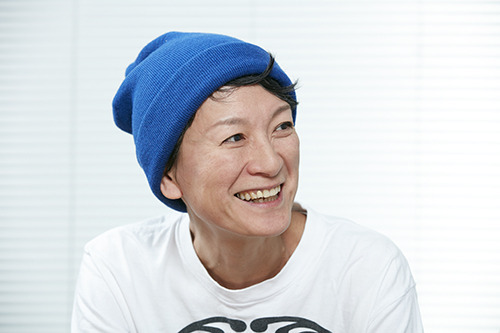
About their private life, Q-ta has been married three times and divorced twice. Their first marriage was with the mangaka Sabe, with whom they had their first daughter. After her birth, the mangaka changed her style a bit and began to make more childish manga and dedicate it to their daughter, like the manga Children's Games, published in 2003, which contains her personal experiences.
Their second marriage was with the poet Koichi Masuno, in between their first son was born. But there were bad feelings between the mangaka and the poet, so after the marriage, Masuno agreed that he would see his son once a month, something that Q-ta tries to avoid. The poet wrote novels and essays showing his resentment and even regret for the divorce (in case you are interested the book is Marriage disqualification, I have only found it in Japanese), in this he said that the mangaka earned more money than him.
Minami's last marriage is with the manga editor and ex-husband of mangaka Marie Yasuhiko, Masami Otsuka. With Masami, they had a son and a daughter, in addition to the son the publisher had with his first wife. So while raising a total of 5 children and taking care of 4 cats, Q-ta Minami managed to publish more than 40 manga, many of which are short stories or one shots, but unfortunately very few have been published outside of Japan.
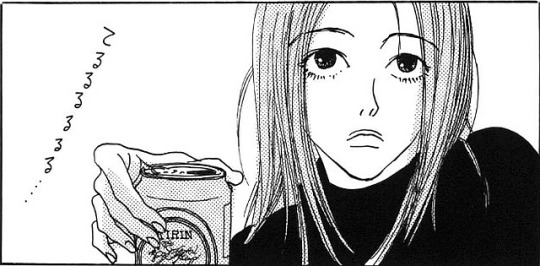
Their drawing style reminds me of Kyoko Okazaki's style. It could be said that mangakas like Q-ta Minami continued with the legacy that the mangaka left empty, even if it was in an unrelated way. In fact, Q-ta is considered post-Kioko. It is noticeable at first glance that their drawings stand out for the almost absence of detail, although the dialogues in his scenes also follow the same pattern. With the slightest bit, the mangaka immerses us in their stories that are closely linked to the day-to-day life of women, girls, adolescents, and young adults.
Their manga are very peculiar (just like Minami) and they are closely linked to the everyday, to the weight of the monotonous and to trying to break that monotony that we have all faced at some point. Or not, the mangaka may simply want to demonstrate the drama that can exist in the "simplicity" of everyday life and, on many occasions, adding eroticism. And something that is a pleasure to read about their mangas is how Q-ta treats the sexuality of women, especially in adolescence/ young woman. Minami isn't t afraid to delve into a topic, which is often silenced or treated from a male gaze, and show how the girls who are the protagonists of their manga enjoy (in many cases) discovering and showing her sexuality.
➳ SAYONOARA MIDORI-CHAN 1997
*It isn't suitable for all audiences. It contains adult material*
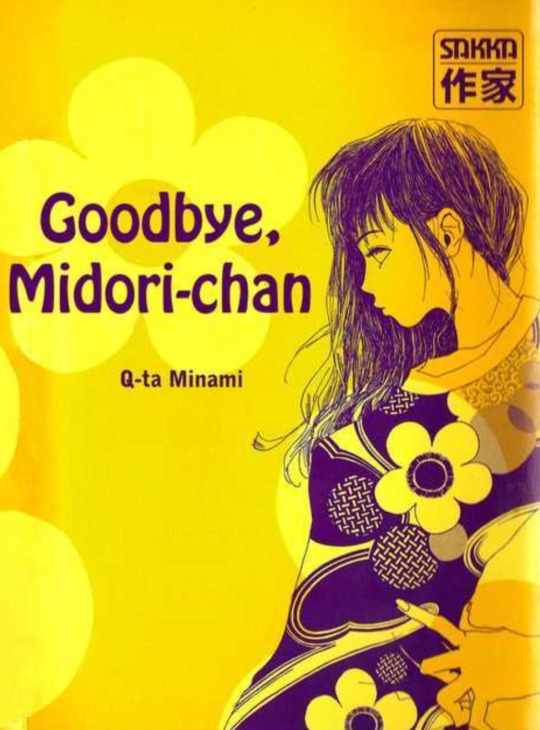

- demographic: josei
- genre: romance, slice of life, drama
- French
Yuko, the protagonist, is a 20-year-old girl who is not very clear about things or what she wants in life, with the exception of one thing, her "boyfriend" Yutaka. She doesn't have hobbies or friends, nor does she look for them, although with two jobs it's not like she has time for it either. At night, she works in a bar next to where Yutaka works. That's where all the misfortunes happen to the protagonist, some even dangerous. Yuko should never have taken that job.
It is a very short story, so risking I will say that you do not expect a sublime masterpiece. Even so, it will surprise you how, in only 7 chapters, the characters are so well written and are so realistic that you can even identify with them. The narrated situations, the union between the employees, the relationship between the protagonists, the friction between the women, etc. They are things that could have happened to you, and that makes it interesting.
- in 2005 it was adapted to live action.
➳ POP LIFE 2016-2018
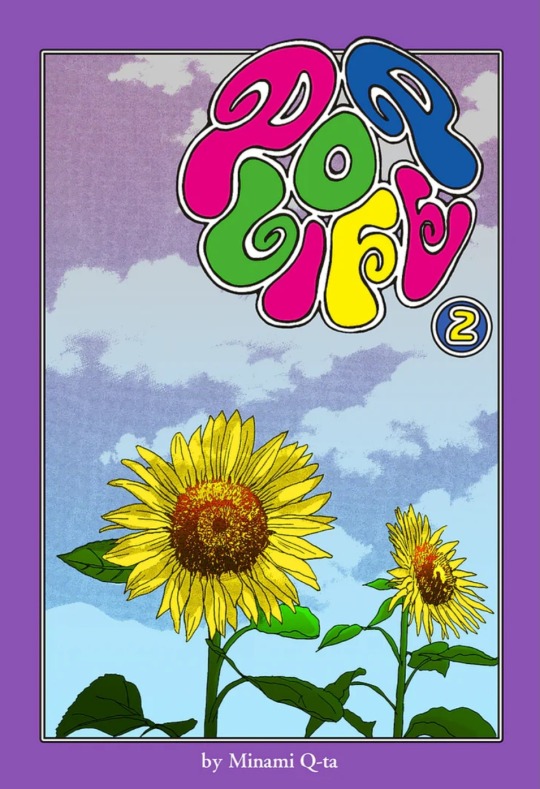

- demographic: seinen
- genre: slice of life
- English
Sakura, a mangaka, and Akemi, an event organizer, are two single mothers who end up living together and supporting each other in raising their children. The two families live in a somewhat small apartment, which could suggest that it makes it difficult for two small children, a 16-year-old teenager and two women, leading a comfortable life. But the reality is completely different and mothers seem to be happier in their new lifestyle than in the life they led before.
A breath of fresh air on motherhood, taken in a realistic way, showing broken families, but in a certain way complete. Although it is not only about motherhood, but also about death or how to handle a divorce. Many of the experiences that we see in both women are taken from the author's life, narrated from another perspective.
➳ HANDS OFF MY GIRL 2005
*It contains adult material*

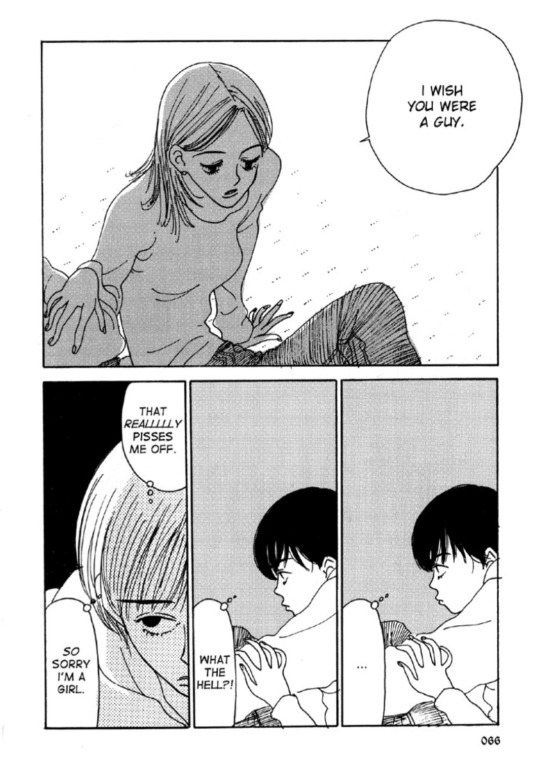
- demographic: josei
- genre: slice of life
- Spanish
It is a compilation of a total of 8 stories, each one with a different genre, but all with the Q-ta Minami touch, so it cannot be classified into a specific genre, although the most abundant is slice of life.
The vast majority of these stories contain explicit sex, from TL to GL (yuri). But it is much deeper, it is not only simple eroticism. Hands off my Girl also deals with topics such as lies, jealousy, infidelity, unrequited romance, etc. Like in the second story, Broken Into Pieces, where the protagonist has sex with the man she loves, but he has a girlfriend, and he is supposed to love her more than the protagonist.
But there is something very curious, and it is that the last two stories have nothing to do with the rest. Diary of Another Young Girl narrates the life of a 10-year-old girl who is always in the clouds, has no friends and only trusts her cousin. And Days Spent with Her is an autobiographical chapter of the mangaka that narrates what a day is like with her and her daughter, who is still a baby.
➳ THE BLOOD RED BOY 2022


- English/ Spanish
- genre: drama, romance, bl
It is a very interesting one shot and only has 16 pages. The protagonists are nothing alike, they lead completely different lives and the only thing they have in common is the bar where they are going to drink and the reality from which they are fleeing. It is a story that touches on topics from gender to loneliness and the search for self-love. These are like pieces of an incomplete puzzle and you are the one who has to fill in the missing gaps.
➳ NOT ALL GIRLS ARE STUPID 1996-1997
*It contains adult material*
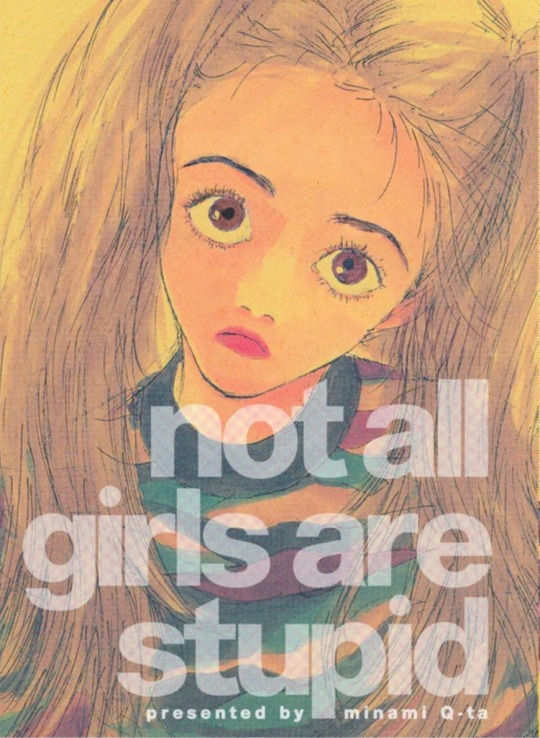

- demographic: josei
- English
Guess what? Another compilation of interesting short stories. Where girls start to discover their sexuality, fall in love, get disappointed and live their lives the way they want. Although there will be misfortunes, toxic relationships, unwanted pregnancies, infidelities and a lot of detail from the Q-ta Minami brand.
Q-ta Minami's stories are not characterized by being extraordinarily long so these are ideal to read when you don't have much time, but I really don't know what you are waiting for to give them a chance.
#q-ta minami#mangaka#manga#feminist#non binary#manga recommendation#japan#Sayonoara Midori-Chan#not all girls are stupid
51 notes
·
View notes
Text
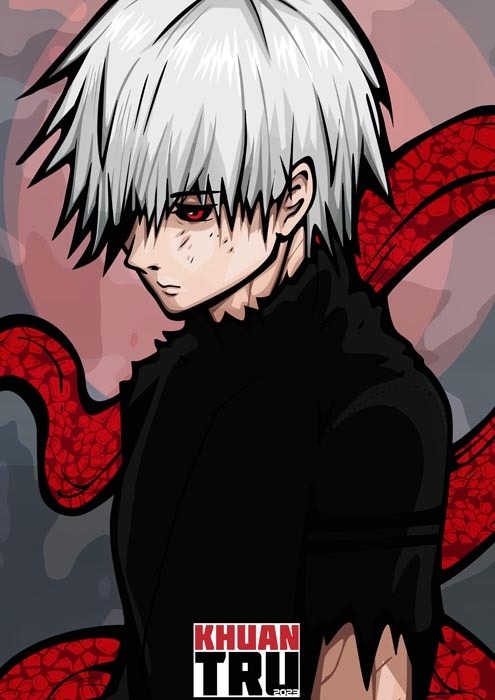
26/09/2023: first one for this morning Tuesday of September. Enjoy everyone
"I'm not the one that's wrong, what's wrong is the world.." - Ken Kaneki
Tools: Intuos Draw pen.
Software: Abdobe Photoshop & Illustrator CS3.
ref: Tokyo Ghoul (anime / Manga)
google ref: Tokyo Ghoul is a Japanese dark fantasy manga series written and illustrated by Sui Ishida. It was serialized in Shueisha's seinen manga magazine Weekly Young Jump from September 2011 to September 2014, with its chapters collected in 14 tankōbon volumes. Wikipedia
#anime#manga#vector#illustration#khuan tru#photoshop#fan art#london#pen tool#pen drawing#fan drawing#Ken Kaneki#tokyo ghoul
13 notes
·
View notes
Text
Let’s Talk Manga Demographics!
Colleen from Colleen's Manga Recs asked me to weigh in when someone had questions regarding manga demographics, so I made a Twitter thread. I figured I'd make a post here too since this topic has many misconceptions—and this is a manga blog after all.

Links to my other manga posts here
Link to my thread on Twitter. I could talk about demographics for hours but I tried to keep it concise and just address the question. I'm going to compare Japan and America because that's what I'm most familiar with.
The tweet I replied to was this:

---
First off, there are various factors that go into why a publisher labels a manga a certain way (combination of art style, story content, etc). There’s also a difference between how publishers in Japan and abroad do things.
Shoujosei/shounen/seinen categorization obviously is a Japanese thing. In America, there’s different but sometimes similar labels (young adult, for example) but it’s not a one-to-one. Overseas publishers probably have more leeway on how they market things because of this. It’s a different market from Japan. EN publishers use imprints and this is meant to replace JP publishers using magazines (also printed on vols). In America, bookstores arrange manga by alphabetical order, no regard for demographics. That was so weird to me the first time I saw it.
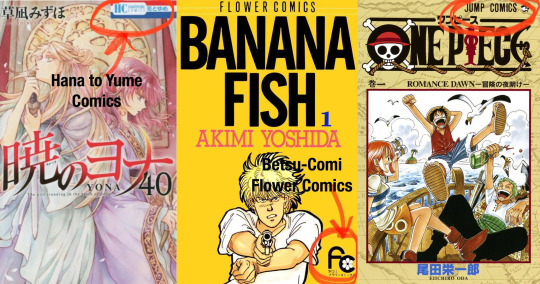
Normally EN manga have imprints, but in Japan it's the magazine it's published in.
Even EN novels are organized in categories and then alphabetical order (by title or author). In Japan, it’s organized by demographic > magazine/publisher > then alphabetical order. Same for ebooks.
You’ll have the shounen section, but Jump titles are labeled on the shelf, and Square Enix titles are grouped together, then arranged by alphabetical order. This goes for both new and used. Even when there’s a separate table for new releases, they tend to group them this way.
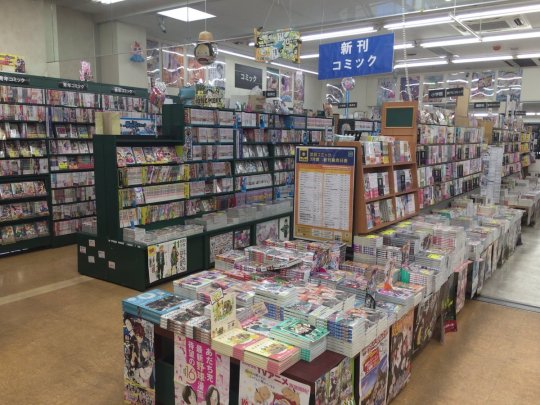
To the left, I can see signs that say “seinen comics”, and the publishers “Shueisha”, “Shogakukan”, and “Kodansha” in the back. New releases are usually end-caps. The blue sign says “New Release Comics”. They tend to keep the demos together for these too.
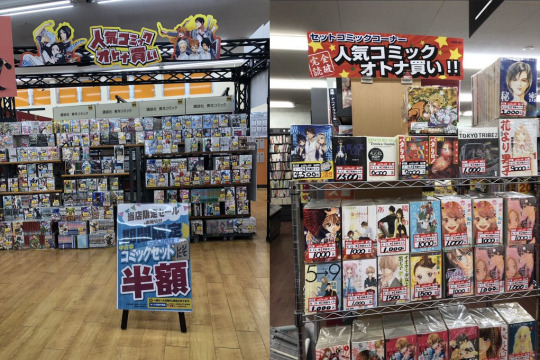
Selling bundles of used series is common, so you can see in these pictures, the one on the left has signs on the shelves that say “Kodansha seinen comics”. Right pic is my local bookoff. It’s not explicitly labeled, but they grouped all the shoujo bundles on the same shelf.

Left: “shoujo comics/lady’s comics” (Josei is often referred to as “lady’s comics” in Japan). “BL-lady’s comics”. Right: the shelves are labeled “Champion”, “Sunday”, “Magazine”, “Jump” which are all shounen magazines.
Colleen had asked me about this for their video (my comment at the 32:04 mark, but watch the whole vid because it’s good!) I wouldn’t be surprised if the thing with Renta JP in the vid was similar to physical bookstores too, because of marketing.
youtube
We stan Colleen🫡
Since the magazines are sold in Japan and not just the tankobon volumes, readers there are likely more familiar with what series are published together under what demographic and what makes them fall under that demographic.
If they switched up what a manga is labeled as in the bookstore versus the magazine, that would muddle things and confuse readers. I can imagine they’d want readers shopping for one title to see their other titles next to it so they buy it. It’s all a part of their brand. But since the magazines aren’t sold outside Japan and the market is different, foreign publishers take liberties. Sometimes I wonder if they should’ve even used JP demos tbh.
Then the same Twitter user asked a follow up that led to more relevant stuff that I hadn't initially mentioned in the thread:
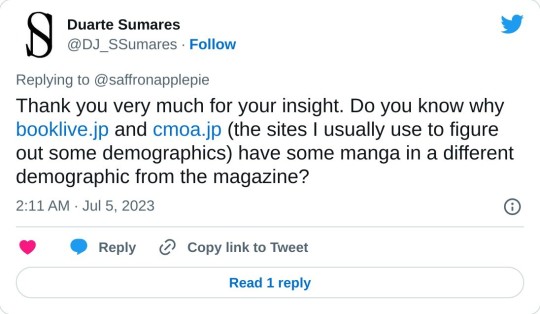
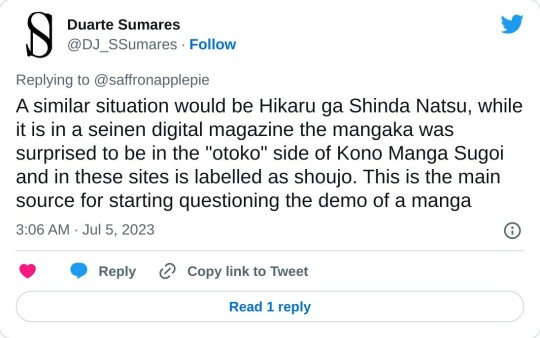

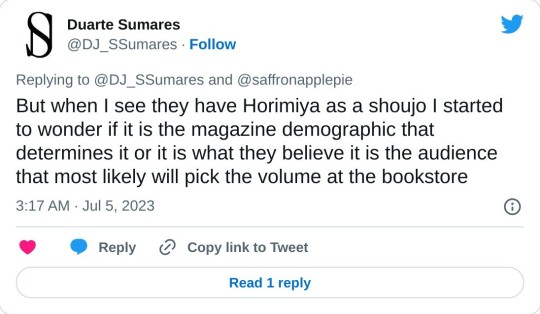
I picked up Hikaru ga Shinda Natsu from my local bookstore back when vol.1 first came out and if I’m not mistaken, it was in the shounen/seinen section. Renta JP has it under “lady’s comics”.
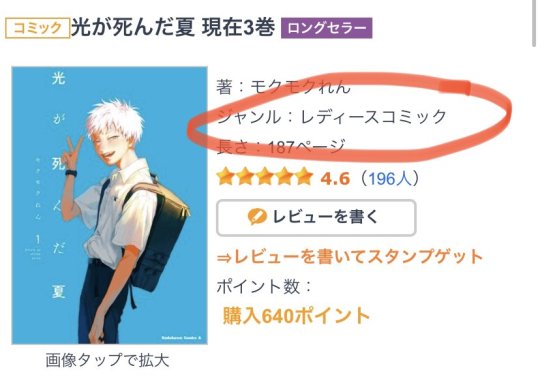
I’m not 100% if this is the reason or not, but BL and horror have a lot of history with shoujosei, so they labeled it as such. In brick and mortar shops, like I said, the publisher would want their titles together so people buy more of their stuff. Online, ebooks don’t have a physical shelf they’re on so the way you’re searching for it is different so perhaps they changed the label for online searches for what gets the most hits. Horimiya is also labeled shoujo on Renta and I’ve seen it in the shoujo section at bookoff, but I don’t think I’ve seen it in shoujo at new bookstores.

It's from a shounen magazine and I still consider it a shounen because of multiple reasons (like art, story style, etc.)
Again, they might be playing around with the labels to optimize marketing for digital versus brick and mortar.
I call this ✨gerrymandering but for comics✨ LOL and there's a reason I used the word "gerrymandering" as it's basically the bullshitting of demographics and it's not a word that has a positive connotation.
But yeah, I hope this was informative!
18 notes
·
View notes
Text
Why Stone Ocean is cursed to be underappreciated
Posting this rant here because I think people might like to read it. Wall of text ahead.
In the manga industry, mainstream publications are usually split by target demographic: shonen for boys/young men, shojo for girls/young women (think Sailor Moon, Rose of Versailles, etc), seinen for young men, and josei for young women are the main four, with shonen being THE thing people think of when they hear the word "manga". Before SBR, Jojo was published in Shueisha's Weekly Shonen Jump, alongside such titans as One Piece, Dragon Ball, and Naruto. And until SO, Jojo pretty well fit in with the shonen demographic, bizarre though it is. Fundamentally, it comes down to cool guys punching each other in cool ways, which shonen readers are absolutely down with.
But then SO comes along. Imagine Araki going to his editors at WSJ and saying "yes, this next part will be centered around a nineteen-year-old American woman in prison". It's a stark contrast to the historically-focused Jonathan or Joseph, or the Japanese cool guys Jotaro and Josuke. The whole premise is absolutely orthogonal to WSJ's target demographic; looking at SO as a whole, it's clear that Araki was pushing boundaries - for example, making Anasui first appear as a woman (he "wanted to make a character that transcended gender", which ironically FF ended up doing in the anime).
All this is anathema to the famously formulaic shonen genre, where the friendly, big-eater protagonist with a good heart who never gives up defeats enemies with the power of friendship, even from his hot-headed, abusive rival/frenemy, and also there is a Designated Girl there for some reason. There were few other WSJ titles with female protagonists; the only contemporary that comes to mind is Claymore, which only got a few months in WSJ, starting and ending in Shueisha's adjacent, less-renowned monthly publications Monthly Shonen Jump and Jump Square. (These days, there are more titles with female leads in WSJ, like The Promised Neverland, and, uhh... hm. The Emperor and I, I guess? Maybe you could argue for Spy x Family and Chainsaw Man part 2?)
In other words, SO pushed the envelope in many big ways. Interestingly, we already saw Araki start to expand his creativity beyond the shonen genre a little in DiU, and definitely in VA, where he starts to delve deeper into his idea of "fate", and where there are rumors about how Giorno was originally supposed to be a girl. But it's not just feminism - the story itself is complicated, with postmodernist touches that bring the reader's own experience into the story (i.e. the ending) and all the classic Jojo bullshit cranked up to 11 (frogs, snails, rods, "assassination feng shui"...). So it didn't exactly resonate with, say, Dragon Ball's reader base.
The final thing to remember is that SO ran from 1999-2003. All these themes that we're much more accepting of now - I mostly mean messing with gender roles - were not so unremarkable 20 years ago (at least in America; I can't comment on the gender politics of millennial Japan). It's not ancient history, but times have certainly changed; look at Guilty Gear's Bridget controversy, and ask yourself how that would've gone down in 2000, when virtually no one was coming out in support of trans people. To put Jolyne and Hermes and FF, and their bizarre adventure, in that context - it just didn't resonate with the world at the time.
For SBR and Jojolion (and, now, Jojolands), Araki moved to seinen magazine Ultra Jump, where he could be more creative and more adult. Stone Ocean got screwed over in a lot of unfortunate ways, but in my opinion the main thing was the growing pains of Araki's maturing storytelling, which just didn't jive with the typical shonen reader. The fact that Stone Ocean got published and sold at all is a testament to his existing reputation.
So yes, SO is massively underrated, and seems to have a curse on it to that effect, given how the anime adaptation was screwed over by covid (and, according to some, Netflix’s distribution). It's subtle and daring and complicated, which people reading Jojo for the fights didn't really go for. But it was not only a foreshadowing of Araki's even more matured storytelling in SBR and Jojolion, it's a magnificent work in its own right, and deserves to be appreciated as such.
(More can be said by anyone who actually has experience in the pre-2012 Jojo fandom either in the West or in Japan, which I don’t.)
38 notes
·
View notes
Text
The 2 Girlfriends Who Really, Really, Really Love You (98 to Go)
dailymotion
#The 100 Girlfriends Who Really Really Really Really Really Love You#君のことが大大大大大好きな100人の彼女#Anime Fall 2023#Kimi no koto ga Daisuki na 100-nin no Kanojo#The 100 Girlfriends#100人の彼女#100-nin no Kanojo#Rikito Nakamura#Yukiko Nozawa#Shueisha's#Bibury Animation Studios#Seven Seas Entertainment#Weekly Young Jump#seinen manga#Shueisha's seinen manga
0 notes
Text

Super Jump (スーパージャンプ) / Shūeisha (集英社) / Promotional phone card
#vintage manga#seinen manga#80s manga#shonen jump#tsukasa hojo#shueisha#promotional material#スーパージャンプ#集英社
34 notes
·
View notes
Text
Silver Talks AniManga (11/02/24)
very sad weeks back to back, losing two good manga in cipher and mma, while other worse series continue along but oh well
green - new series/new to me
blue - finale/completed

Anime
Undead Unluck Ep18
it's a shame these past few eps have been so heavy on recapping past stuff, to the point where most of the footage in the ep is reused. hope it isn't a sign there's underlying production issues. considering the nature of the next episode there's prob also gonna be a lot recaps but after we get into the autumn arc proper I hope it goes back to normal or it'll be worrying
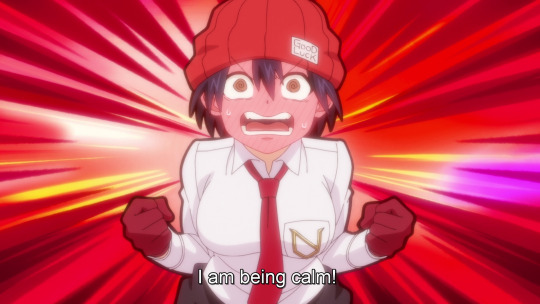
Pokemon Horizons Ep39
the last few have been p weak so this one was pretty good in comparison. I haven't played scarvi yet but I've always liked tinktaton's design and this made me like it even more. it's a cute little creature, looking forward to see it being part of the cast in the future

Manga
Super Psychic Policeman Chojo Ch1
hey for a gag manga that was pretty decent, much better than ichigoki at least, not like that's hard. reminded me a lot of saiki but that's for obvious reasons.
the author had a manga some years ago, samon the summoner, tho I never read it myself I knew it existed and saw it around sometimes.
anyway like I said, this first chap was p decent, suffered a bit from pacing and repeating gags, but when it's the normal lenght it'll probably be fine. I'm not usually the biggest fan of gag manga like this, but this chap alone was a lot more tolerable than ichigoki so I'll be looking forward to maybe being surprised by it

Martial Master Asumi Ch32 (Finale)
it's a real shame mma got axed like this. kawada is a jump veteran and it really shows, everything about the series was a lot more polished and well executed than the other newcomers but it got axed while something like nue, shockingly, continues to truck along. it's a shame jp readers seem to have such bad taste in recent years with good series getting canceled too early while others stick around for way too long.
anyway, it's a good manga.
art's really good and the fights are cool and easy to follow. the cast, including the rivals, is all likeable. the cameos from hinomaru sumo characters was also cool (the author's previous work). it also portrayed dementia really well and respectfully so that was a nice thing to see.
I was originally gonna give it an 8, then decided to bump it down to 7 cause it got cut short and felt like it didn't do everything it could've, but after looking at my scores for some other canceled series I decided to bump it up to 8 after all.
looking forward to kawada's next manga. hopefully shueisha puts him in another magazine, doing a seinen or something, where a more mature audience can appreciate him


Two on Ice Ch19
only commenting on this cause the chapter's title was "I Write Sins Not Tragedies" which made me lose my mind cause there's no way it's a reference to that song right? and then I read the chap and it actually is, this shit hit me so outta nowhere it gave me whiplash.
I know the author referenced a justin bieber song in an early chap but he's mainstream so while weird to see in a manga I didn't think much of it, unlike this which took me completely by surprise
anyway this series should be getting axed for the next serialization series so I'll talk about it again then probably
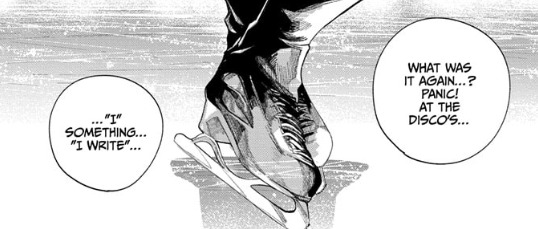
4 notes
·
View notes
Note
i love your posts but you're really annoying sometimes
JoJo's Bizarre Adventure (Japanese: ジョジョの奇妙な冒険, Hepburn: JoJo no Kimyō na Bōken) is a Japanese manga series written and illustrated by Hirohiko Araki. It was originally serialized in Shueisha's shōnen manga magazine Weekly Shōnen Jump from 1987 to 2004, and was transferred to the monthly seinen manga magazine Ultra Jump in 2005. The series is divided into nine story arcs, each following a new protagonist bearing the "JoJo" nickname. JoJo's Bizarre Adventure is Shueisha's largest ongoing manga series by volume count, with its chapters collected in 130 tankōbon volumes as of May 2021.
A 13-episode original video animation series adapting the manga's third part, Stardust Crusaders, was produced by A.P.P.P. and released from 1993 to 2002. The studio later produced an anime film adapting the first part, Phantom Blood, which was released in theaters in Japan in 2007. In October 2012, an anime television series produced by David Production adapting Phantom Blood and Battle Tendency began broadcast on Tokyo MX. As of December 2021, the studio has produced five seasons adapting through the manga's sixth part, Stone Ocean. A live-action film based on the fourth part, Diamond Is Unbreakable, was released in Japan in 2017.
JoJo's Bizarre Adventure is well-known for its art style and poses; frequent references to Western popular music and fashion; and battles centered around Stands, psycho-spiritual manifestations with unique supernatural abilities. The series had over 120 million copies in circulation as of December 2021, making it one of the best-selling manga series in history, and it has spawned a media franchise including one-shot manga, light novels, and video games. The manga, TV anime, and live-action film are licensed in North America by Viz Media, which has produced various English-language releases of the series since 2005.
Plot
See also:
List of JoJo's Bizarre Adventure characters
The universe of JoJo's Bizarre Adventure is a reflection of the real world with the added existence of supernatural forces and beings. In this setting, some people are capable of transforming their inner spiritual power into a Stand (スタンド, Sutando); another significant form of energy is Hamon (波紋, "Ripple"), a martial arts technique that allows its user to focus bodily energy into sunlight via controlled breathing. The narrative of JoJo's Bizarre Adventure is split into parts with independent stories and different characters. Each of the series' protagonists is a member of the Joestar family, whose mainline descendants possess a star-shaped birthmark above their left shoulder blade and a name that can be abbreviated to the titular "JoJo". The first six parts take place within a single continuity whose generational conflict stems from the rivalry between Jonathan Joestar and Dio Brando, while the latter two parts take place in an alternate universe where the Joestar family tree is heavily altered.
Part 1: Phantom Blood (ファントムブラッド, Fantomu Buraddo)
Volumes 1–5, 44 chapters. In late 19th-century England, Jonathan Joestar, the young son of a wealthy landowner, meets his new adopted brother Dio Brando, who loathes him and plans to usurp him as heir to the Joestar family. When Dio's attempts are thwarted, he transforms himself into a vampire using an ancient Stone Mask and destroys the Joestar estate. Jonathan embarks on a journey, meets new allies, and masters the Hamon (波紋, "Ripple") martial arts technique to stop Dio, who has made world domination his new goal.
Part 2: Battle Tendency (戦闘潮流, Sentō Chōryū)
Volumes 5–12, 69 chapters. In 1938, a German expedition discovers and awakens a Pillar Man, a powerful humanoid whose race created the Stone Mask. The Pillar Man kills the researchers and escapes to awaken the other Pillar Men so that they may regain dominance over humanity by obtaining the Red Stone of Aja. Joseph Joestar, Jonathan's grandson, unites with new allies and masters Hamon to defeat the Pillar Men.
Part 3: Stardust Crusaders (スターダストクルセイダース, Sutādasuto Kuruseidāsu)
Volumes 13–28, 152 chapters. In 1989, Dio Brando (now referred to as "DIO") awakens after his tomb is salvaged from the ocean. Because Dio had managed to capture Jonathan's body, Stands (スタンド, Sutando) awaken in Jonathan's descendants, consisting of Joseph, his daughter Holly Kujo, and grandson Jotaro Kujo. Holly, however, is unable to cope with her own Stand, and has only 50 days to live. Jotaro, Joseph, and their new allies set out to defeat Dio before this deadline expires, and encounter Dio's henchmen along the way.
Part 4: Diamond Is Unbreakable (ダイヤモンドは砕けない, Daiyamondo wa Kudakenai)
Volumes 29–47, 174 chapters. In 1999, the Joestar family learns that Joseph has an illegitimate son, Josuke Higashikata, who lives in the fictional Japanese town of Morioh. Josuke learns of a mystical Bow and Arrow that bestows Stands upon those struck by its arrowheads. As they hunt down the Bow and Arrow, Josuke and his allies encounter a serious threat in the form of the Stand-using serial killer Yoshikage Kira.
Part 5: Golden Wind (黄金の風, Ōgon no Kaze)
Volumes 47–63, 155 chapters. In 2001, in Naples, Italy, Giorno Giovanna is the son of Dio, conceived while he was in possession of Jonathan Joestar's body. Giorno seeks to become a mafia boss in order to eliminate drug dealers who sell their wares to children. His team, which consists of Stand users, must confront the mafia boss Diavolo and protect his daughter Trish Una, whom Diavolo intends to kill in order to hide his identity.
Part 6: Stone Ocean (ストーンオーシャン, Sutōn Ōshan)
Volumes 64–80, 158 chapters. In 2011, near Port St. Lucie, Florida, Jotaro Kujo's daughter Jolyne Cujoh is framed for murder and sent to prison. She works together with other Stand-using prisoners and her father to hunt down prison chaplain Father Enrico Pucci, loyalist to Dio, who seeks the creation of a new universe shaped to his and Dio's will.
Part 7: Steel Ball Run (スティール・ボール・ラン, Sutīru Bōru Ran)
Volumes 81–104, 95 chapters. In an alternate timeline's 1890, United States President Funny Valentine holds a cross-country horse race with a $50 million reward to the winner. Valentine intends to use the race to gather the scattered parts of a holy corpse for his own nationalistic ends. Racers Gyro Zeppeli and Johnny Joestar uncover Valentine's ploy and must defend themselves from his hired assassins.
Part 8: JoJolion (ジョジョリオン, Jojorion)
Volumes 105–131, 110 chapters. Set in the same universe as Steel Ball Run, in 2012, the town of Morioh has been devastated by the 2011 Tōhoku earthquake and tsunami, which has caused mysterious faults colloquially known as the "Wall Eyes" to appear in town. Local college student Yasuho Hirose discovers a young man buried in the rubble and nicknames him "Josuke". Suffering from amnesia, Josuke tries to uncover the secret of his past as he is also confronted with the activities of a local crime syndicate, which sells the fruit of a mysterious Locacaca tree, capable of healing people and then "taking" something in return.
Part 9: JOJOLANDS (ジョジョランズ, Jojoranzu) (Tentative title)
In the September 2021 issue of Ultra Jump, Araki confirmed that part 9 of the series, tentatively titled JOJOLANDS, would begin following a short break.
10 notes
·
View notes
Text
Confirman la quinta temporada para Kingdom
Prepárate para la guerra en el nuevo video promocional de la quinta temporada de Kingdom (@kingdom_animePR).
Kingdom temporada 5, la adaptación basada en el manga histórico seinen, publicó un dramático trailer para su nueva temporada.
El manga original de Kingdom, creado por Yasuhisa Hara, se serializa en la revista de manga Weekly Young Jump de Shueisha. La quinta temporada se estrenará en enero de 2024.
La quinta temporada de Kingdom se estrenará el 6 de enero en las cadenas…

View On WordPress
0 notes